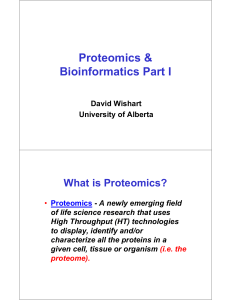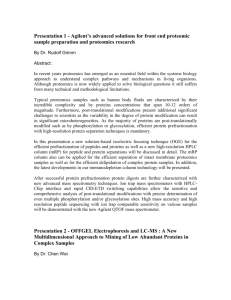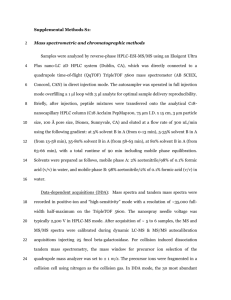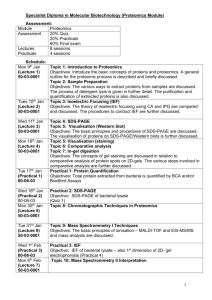Powerpoint - Wishart Research Group
advertisement
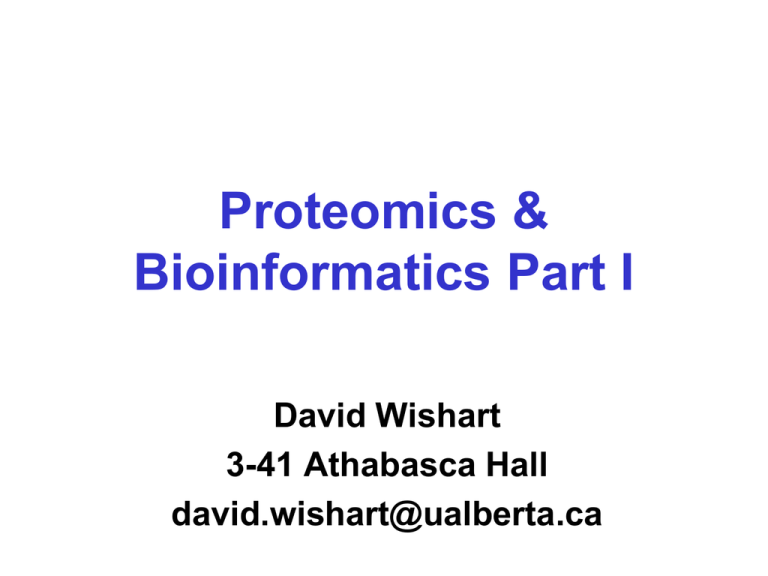
Proteomics & Bioinformatics Part I David Wishart 3-41 Athabasca Hall david.wishart@ualberta.ca Objectives • Learn about the 3 different types of proteomics • Become familiar with expressionbased proteomics techniques • Become familiar with mass spectrometry for protein or peptide ID • Become familiar with some of the software tools and algorithms for peptide/protein ID What is Proteomics?* • Proteomics - A newly emerging field of life science research that uses High Throughput (HT) technologies to display, identify and/or characterize all the proteins in a given cell, tissue or organism (i.e. the proteome). Proteomics & Bioinformatics Genomics Proteomics Bioinformatics 1990 1995 2000 2005 2010 2015 2020 3 Kinds of Proteomics* • Structural Proteomics – High throughput X-ray Crystallography/Modelling – High throughput NMR Spectroscopy/Modelling • Expressional or Analytical Proteomics – Electrophoresis, Protein Chips, DNA Chips, 2D-HPLC – Mass Spectrometry, Microsequencing • Functional or Interaction Proteomics – HT Functional Assays, Ligand Chips – Yeast 2-hybrid, Deletion Analysis, Motif Analysis Expressional Proteomics 2-D Gel QTOF Mass Spectrometry Expressional Proteomics Expressional Proteomics* • To separate, identify and quantify protein expression levels using high throughput technologies • Expectation of 100’s to 1000’s of proteins to be analyzed • Requires advanced technologies and plenty of bioinformatics support Electrophoresis & Proteomics* 2D Gel Electrophoresis • Simultaneous separation and detection of ~2000 proteins on a 20x25 cm gel • Up to 10,000 proteins can be seen using optimized protocols Why 2D GE?* • Oldest method for large scale protein separation (since 1975) • Still most popular method for protein display and quantification • Permits simultaneous detection, display, purification, identification, quantification • Robust, increasingly reproducible, simple, cost effective, scalable & parallelizable • Provides pI, MW, quantity Steps in 2D GE & Peptide ID • Sample preparation • Isoelectric focusing (first dimension) • SDS-PAGE (second dimension) • Visualization of proteins spots • Identification of protein spots • Annotation & spot evaluation 2D Gel Principles* SDS PAGE Isoelectric Focusing (IEF) IEF Principles* Increasing pH A N O D E _ _ _ _ _ _ _ _ _ + + + + + + + + + pI = 5.1 pI = 6.4 pI = 8.6 C A T H O D E Isoelectric Focusing* • • • • • Separation of basis of pI, not Mw Requires very high voltages (5000V) Requires a long period of time (10h) Presence of a pH gradient is critical Degree of resolution determined by slope of pH gradient and electric field strength • Uses ampholytes to establish pH gradient • Can be done in “slab” gels or in strips (IPG strips for 2D gel electrophoresis) Steps in 2D GE & Peptide ID • Sample preparation • Isoelectric focusing (first dimension) • SDS-PAGE (second dimension) • Visualization of proteins spots • Identification of protein spots • Annotation & spot evaluation SDS PAGE SDS PAGE Tools SDS PAGE Principles* SO4 Na + Sodium Dodecyl Sulfate C A T H O D E _ _ _ _ _ _ _ _ _ _ _ _ _ _ _ _ _ _ _ _ _ _ _ _ _ _ _ _ _ _ _ _ _ _ _ _ + + + + + + + A N O D E SDS-PAGE Principles* Loading Gel Running Gel SDS-PAGE • • • • Separation of basis of MW, not pI Requires modest voltages (200V) Requires a shorter period of time (2h) Presence of SDS is critical to disrupting structure and making mobility ~ 1/MW • Degree of resolution determined by %acrylamide & electric field strength SDS-PAGE for 2D GE • After IEF, the IPG strip is soaked in an equilibration buffer (50 mM Tris, pH 8.8, 2% SDS, 6M Urea, 30% glycerol, DTT, tracking dye) • IPG strip is then placed on top of pre-cast SDS-PAGE gel and electric current applied • This is equivalent to pipetting samples into SDS-PAGE wells (an infinite #) SDS-PAGE for 2D GE equilibration SDS-PAGE 2D Gel Reproducibility Advantages and Disadvantages of 2D GE* • Provides a hard-copy record of separation • Allows facile quantitation • Separation of up to 9000 different proteins • Highly reproducible • Gives info on Mw, pI and post-trans modifications • Inexpensive • Limited pI range (4-8) • Proteins >150 kD not seen in 2D gels • Difficult to see membrane proteins (>30% of all proteins) • Only detects high abundance proteins (top 30% typically) • Time consuming Protein Detection* • Coomassie Stain (100 ng to 10 mg protein) • Silver Stain (1 ng to 1 mg protein) • Fluorescent (Sypro Ruby) Stain (1 ng & up) C2H 5 C2H5 CH2 N C O3S N CH3 CH2 SO3 Coomassie R-250 N H 5 C2 C2 H5 Stain Examples Coomassie Silver Stain Copper Stain Multicolor Staining with Sypro fluorescent stains Steps in 2D GE & Peptide ID • Sample preparation • Isoelectric focusing (first dimension) • SDS-PAGE (second dimension) • Visualization of proteins spots • Identification of protein spots • Annotation & spot evaluation Protein Identification* • 2D-GE + MALDI-MS – Peptide Mass Fingerprinting (PMF) • 2D-GE + MS-MS – MS Peptide Sequencing/Fragment Ion Searching • Multidimensional LC + MS-MS – ICAT Methods (isotope labelling) – MudPIT (Multidimensional Protein Ident. Tech.) • 1D-GE + LC + MS-MS • De Novo Peptide Sequencing 2D-GE + MALDI (PMF)* Trypsin + Gel punch p53 Trx G6PDH 2D-GE + MS-MS Trypsin + Gel punch p53 MudPIT IEX-HPLC Trypsin + proteins p53 RP-HPLC ICAT (Isotope Coded Affinity Tag)* Mass Spectrometry • Analytical method to measure the molecular or atomic weight of samples MS Principles* • Find a way to “charge” an atom or molecule (ionization) • Place charged atom or molecule in a magnetic field or subject it to an electric field and measure its speed or radius of curvature relative to its mass-to-charge ratio (mass analyzer) • Detect ions using microchannel plate or photomultiplier tube Mass Spec Principles* Sample + _ Ionizer Mass Analyzer Detector Typical Mass Spectrometer Matrix-Assisted Laser Desorption Ionization 337 nm UV laser cyano-hydroxy cinnamic acid MALDI MALDI Ionization* Matrix + + +-+ Laser Analyte + + ++ + --+ -+ + + + + + • Absorption of UV radiation by chromophoric matrix and ionization of matrix • Dissociation of matrix, phase change to supercompressed gas, charge transfer to analyte molecule • Expansion of matrix at supersonic velocity, analyte trapped in expanding matrix plume (explosion/”popping”) MALDI Spectra (Mass Fingerprint) Tumor Masses in MS* • Monoisotopic mass is the mass determined using the masses of the most abundant isotopes • Average mass is the abundance weighted mass of all isotopic components Amino Acid Residue Masses Monoisotopic Mass Glycine Alanine Serine Proline Valine Threonine Cysteine Isoleucine Leucine Asparagine 57.02147 71.03712 87.03203 97.05277 99.06842 101.04768 103.00919 113.08407 113.08407 114.04293 Aspartic acid Glutamine Lysine Glutamic acid Methionine Histidine Phenylalanine Arginine Tyrosine Tryptophan 115.02695 128.05858 128.09497 129.04264 131.04049 137.05891 147.06842 156.10112 163.06333 186.07932 Amino Acid Residue Masses Average Mass Glycine Alanine Serine Proline Valine Threonine Cysteine Isoleucine Leucine Asparagine 57.0520 71.0788 87.0782 97.1167 99.1326 101.1051 103.1448 113.1595 113.1595 114.1039 Aspartic acid Glutamine Lysine Glutamic acid Methionine Histidine Phenylalanine Arginine Tyrosine Tryptophan 115.0886 128.1308 128.1742 129.1155 131.1986 137.1412 147.1766 156.1876 163.1760 186.2133 Calculating Peptide Masses • • • • • • • Sum the monoisotopic residue masses Add mass of H2O (18.01056) Add mass of H+ (1.00785 to get M+H) If Met is oxidized add 15.99491 If Cys has acrylamide adduct add 71.0371 If Cys is iodoacetylated add 58.0071 Other modifications are listed at – http://prowl.rockefeller.edu/aainfo/deltamassv2.html • Only consider peptides with masses > 400 Peptide Mass Fingerprinting (PMF) Peptide Mass Fingerprinting* • Used to identify protein spots on gels or protein peaks from an HPLC run • Depends of the fact that if a peptide is cut up or fragmented in a known way, the resulting fragments (and resulting masses) are unique enough to identify the protein • Requires a database of known sequences • Uses software to compare observed masses with masses calculated from database Principles of Fingerprinting* Sequence >Protein 1 acedfhsakdfqea sdfpkivtmeeewe ndadnfekqwfe >Protein 2 acekdfhsadfqea sdfpkivtmeeewe nkdadnfeqwfe >Protein 3 acedfhsadfqeka sdfpkivtmeeewe ndakdnfeqwfe Mass (M+H) Tryptic Fragments 4842.05 acedfhsak dfgeasdfpk ivtmeeewendadnfek gwfe 4842.05 acek dfhsadfgeasdfpk ivtmeeewenk dadnfeqwfe 4842.05 acedfhsadfgek asdfpk ivtmeeewendak dnfegwfe Principles of Fingerprinting* Sequence Mass (M+H) >Protein 1 acedfhsakdfqea sdfpkivtmeeewe ndadnfekqwfe 4842.05 >Protein 2 acekdfhsadfqea sdfpkivtmeeewe nkdadnfeqwfe 4842.05 >Protein 3 acedfhsadfqeka sdfpkivtmeeewe ndakdnfeqwfe 4842.05 Mass Spectrum Predicting Peptide Cleavages http://web.expasy.org/peptide_cutter/ http://web.expasy.org/peptide_cutter/peptidecutter_enzymes.html Protease Cleavage Rules Trypsin XXX[KR]--[!P]XXX Chymotrypsin XX[FYW]--[!P]XXX Lys C XXXXXK-- XXXXX Asp N endo XXXXXD-- XXXXX CNBr XXXXXM--XXXXX Why Trypsin?* • • • • • • Robust, stable enzyme Works over a range of pH values & Temp. Quite specific and consistent in cleavage Cuts frequently to produce “ideal” MW peptides Inexpensive, easily available/purified Does produce “autolysis” peaks (which can be used in MS calibrations) – 1045.56, 1106.03, 1126.03, 1940.94, 2211.10, 2225.12, 2283.18, 2299.18 Preparing a Peptide Mass Fingerprint Database • Take a protein sequence database (SwissProt or nr-GenBank) • Determine cleavage sites and identify resulting peptides for each protein entry • Calculate the mass (M+H) for each peptide • Sort the masses from lowest to highest • Have a pointer for each calculated mass to each protein accession number in databank Building A PMF Database Sequence DB Calc. Tryptic Frags >P12345 acedfhsakdfqea sdfpkivtmeeewe ndadnfekqwfe acedfhsak dfgeasdfpk ivtmeeewendadnfek gwfe >P21234 acekdfhsadfqea sdfpkivtmeeewe nkdadnfeqwfe acek dfhsadfgeasdfpk ivtmeeewenk dadnfeqwfe >P89212 acedfhsadfqeka sdfpkivtmeeewe ndakdnfeqwfe acedfhsadfgek asdfpk ivtmeeewendak dnfegwfe Mass List 450.2017 (P21234) 609.2667 (P12345) 664.3300 (P89212) 1007.4251 (P12345) 1114.4416 (P89212) 1183.5266 (P12345) 1300.5116 (P21234) 1407.6462 (P21234) 1526.6211 (P89212) 1593.7101 (P89212) 1740.7501 (P21234) 2098.8909 (P12345) The Fingerprint (PMF) Algorithm* • Take a mass spectrum of a trypsincleaved protein (from gel or HPLC peak) • Identify as many masses as possible in spectrum (avoid autolysis peaks) • Compare query masses with database masses and calculate # of matches or matching score (based on length and mass difference) • Rank hits and return top scoring entry – this is the protein of interest Query (MALDI) Spectrum 1007 1199 2211 (trp) 609 2098 450 1940 (trp) 698 500 1000 1500 2000 2500 Query vs. Database Query Masses Database Mass List 450.2201 609.3667 698.3100 1007.5391 1199.4916 2098.9909 450.2017 (P21234) 609.2667 (P12345) 664.3300 (P89212) 1007.4251 (P12345) 1114.4416 (P89212) 1183.5266 (P12345) 1300.5116 (P21234) 1407.6462 (P21234) 1526.6211 (P89212) 1593.7101 (P89212) 1740.7501 (P21234) 2098.8909 (P12345) Results 2 Unknown masses 1 hit on P21234 3 hits on P12345 Conclude the query protein is P12345 What You Need To Do PMF* • • • • • • • • A list of query masses (as many as possible) Protease(s) used or cleavage reagents Databases to search (SWProt, Organism) Estimated mass and pI of protein spot (opt) Cysteine (or other) modifications Minimum number of hits for significance Mass tolerance (100 ppm = 1000.0 ± 0.1 Da) A PMF website (Prowl, ProFound, Mascot, etc.) PMF on the Web • ProFound • http://prowl.rockefeller.edu/prowl-cgi/profound.exe • Mascot • http://www.matrixscience.com • ProteinProspector – http://prospector.ucsf.edu/prospector/mshome.htm ProFound ProFound (PMF) What Are Missed Cleavages? Sequence >Protein 1 acedfhsakdfqea sdfpkivtmeeewe ndadnfekqwfe Tryptic Fragments (no missed cleavage) acedfhsak (1007.4251) dfgeasdfpk (1183.5266) ivtmeeewendadnfek (2098.8909) gwfe (609.2667) Tryptic Fragments (1 missed cleavage) acedfhsak (1007.4251) dfgeasdfpk (1183.5266) ivtmeeewendadnfek 2098.8909) gwfe (609.2667) acedfhsakdfgeasdfpk (2171.9338) ivtmeeewendadnfekgwfe (2689.1398) dfgeasdfpkivtmeeewendadnfek (3263.2997) ProFound Results MASCOT MASCOT Mascot Scoring* • The statistics of peptide fragment matching in MS (or PMF) is very similar to the statistics used in BLAST • The scoring probability follows an extreme value distribution • High scoring segment pairs (in BLAST) are analogous to high scoring mass matches in Mascot • Mascot scoring is much more robust than arbitrary match cutoffs (like % ID) Extreme Value Distribution* 8000 -x P(x) = 1 - e -e 7000 6000 5000 4000 3000 2000 1000 0 <20 30 40 50 60 70 80 90 100 110 >120 Cumulative Score Extending HSP’s X E = kNe -ls Number of HSP’s found purely by chance S T Extension (# aa) Mascot/Mowse Scoring* • The Mascot Score is given as S = -10*Log(P), where P is the probability that the observed match is a random event • Try to aim for probabilities where P<0.05 (less than a 5% chance the peptide mass match is random) • Mascot scores greater than 67 are significant (p<0.05). Advantages of PMF* • Uses a “robust” & inexpensive form of MS (MALDI) • Doesn’t require too much sample optimization • Can be done by a moderately skilled operator (don’t need to be an MS expert) • Widely supported by web servers • Improves as DB’s get larger & instrumentation gets better • Very amenable to high throughput robotics (up to 500 samples a day) Limitations With PMF* • Requires that the protein of interest already be in a sequence database • Spurious or missing critical mass peaks always lead to problems • Mass resolution/accuracy is critical, best to have <20 ppm mass resolution • Generally found to only be about 40% effective in positively identifying gel spots Steps in 2D GE & Peptide ID • Sample preparation • Isoelectric focusing (first dimension) • SDS-PAGE (second dimension) • Visualization of proteins spots • Identification of protein spots • Annotation & spot evaluation 2D Gel Software Commercial Software • Melanie 7 (GeneBio - Windows only) – http://world-2dpage.expasy.org/melanie/ • ImageMaster 2D Platinum (GeneBio) – http://www.genebio.com/products/melanie/ • Progenesis SameSpots – http://www.totallab.com/products/ • PDQuest 7.1 (BioRad - Windows only) – http://www.bio-rad.com Common Software Features* • • • • Image contrast and coloring Gel annotation (spot selection & marking) Automated peak picking Spot area determination (Integration) – This allows one to quantify protein samples • Matching/Morphing/Landmarking 2 gels • Stacking/Aligning/Comparing gels • Annotation copying between 2 gels Expressional Proteomics Summary (1) • Sample preparation • 2D electrophoresis or 2D HPLC separation • Visualization of proteins spots/peaks • Identification of protein spots/peaks • Annotation & spot evaluation 3 Kinds of Proteomics • Structural Proteomics – High throughput X-ray Crystallography/Modelling – High throughput NMR Spectroscopy/Modelling • Expressional or Analytical Proteomics – Electrophoresis, Protein Chips, DNA Chips, 2D-HPLC – Mass Spectrometry, Microsequencing • Functional or Interaction Proteomics – HT Functional Assays, Protein Chips, Ligand Chips – Yeast 2-hybrid, Deletion Analysis, Motif Analysis
